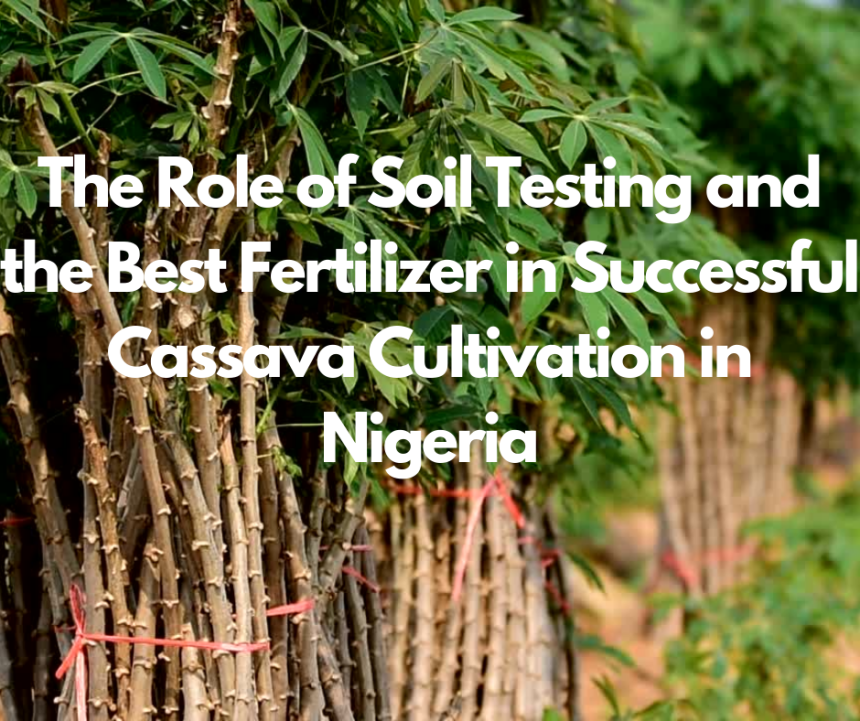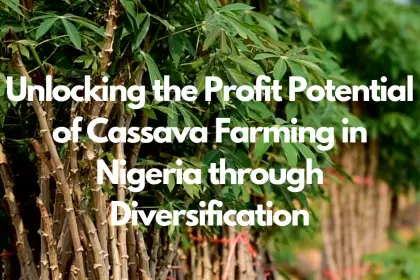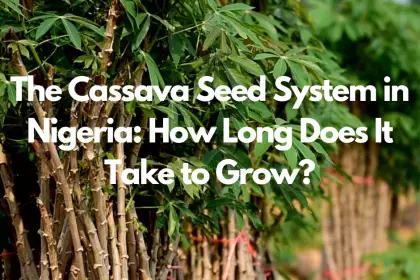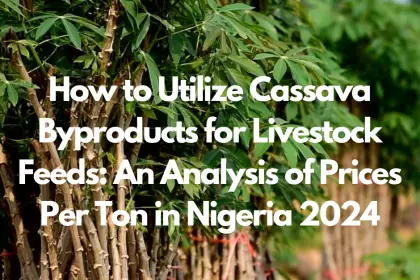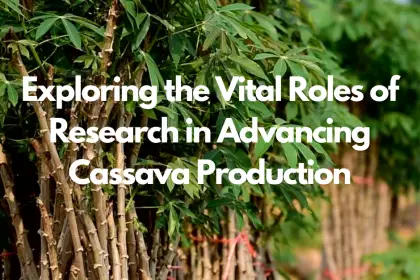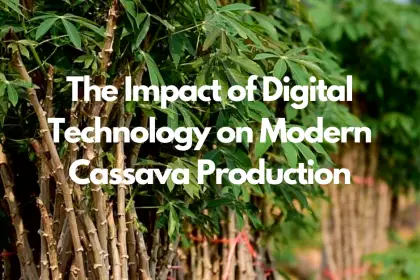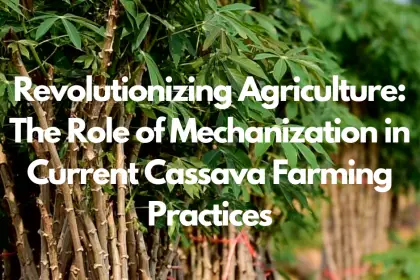Cassava cultivation represents a cornerstone of agriculture in Nigeria, holding significant implications for the nation’s food security and rural economy. Research conducted in Kwara State exemplifies the critical role soil testing plays in identifying the best fertilizer for cassava in Nigeria, revealing stark differences in soil suitability and fertility across regions. This highlights the urgent need for farmers to employ effective soil management strategies, enhancing cassava yield and optimizing crop health.
Understanding the intricate relationship between soil properties and cassava productivity guides farmers towards making informed decisions on the use of fertilizers and organic manure. The findings underscore the importance of tailored nutrient management in fostering successful cassava cultivation in Nigeria. This article delves into the essentials of soil testing, the selection of the best fertilizer for cassava, and the practical approaches to overcoming cultivation challenges, setting a foundation for sustainable agricultural practices in the region.
The Fundamentals of Soil Testing in Cassava Cultivation
Soil testing emerges as a pivotal step in cassava farming across Nigeria, given the diverse soil conditions and specific nutrient requirements essential for optimal growth. Laboratories dedicated to soil testing in Nigeria undertake a detailed analysis of soil samples, focusing on key parameters such as pH levels, nutrient content, and the percentage of organic matter. These analyses are crucial for determining the soil’s suitability for cassava cultivation and for identifying the best fertilizer for cassava in Nigeria.
- pH Level and Nutrient Requirements:
-
- Ideal pH Range: 5.0 – 6.5
- Essential Nutrients: Nitrogen (N), Phosphorus (P), and Potassium (K)
-
- Nitrogen is crucial for the development of leaves and stems.
- Phosphorus supports root development and crop maturity.
- Potassium contributes to overall plant health and resistance to diseases.
- Recommended Nutrient Levels:
-
- Nitrogen: 100-150 kg/ha
- Phosphorus: 40-60 kg/ha
- Potassium: 80-120 kg/haSoil testing frequency varies based on farm history and soil type, with recommendations ranging from every 2-3 years for stable soils to annually for sandy soils. The cost of soil testing in Nigeria is estimated between 2,500 to 5,000 Naira per sample, influenced by the laboratory and the extent of services provided. Utilizing soil test results, farmers are empowered to make informed decisions regarding fertilizer application and crop management practices, potentially increasing cassava yield by 20-30%.
Understanding Nutrient Management for Cassava
Cassava’s resilience in various soil conditions, including those with low levels of phosphorus and high tolerance to acidic soils, underscores its adaptability. The plant’s symbiotic relationship with vesicular-arbuscular mycorrhizae enhances phosphorus absorption, critical for healthy growth. This adaptability does not negate the importance of balanced nutrient management for optimal yield. A combination of mineral and organic fertilizers ensures higher and more sustainable yields. Key points include:
- Essential Nutrients for Cassava:
-
- Nitrogen (N): Vital for stem and leaf growth.
- Phosphorus (P): Powers root development and plant maturity.
- Potassium (K): Enhances plant health and disease resistance.
- Nutrient Management Strategies:
-
- Organic Matter Recycling: Returning plant tops to the soil enriches it with organic matter.
- Balanced Fertilization: A mix of mineral and organic sources is preferred for sustainable yields.
- Annual Requirements: To maintain soil fertility and yield, cassava requires per hectare applications of 50-100 kg of N, 65-80 kg of K, and 10-20 kg of P.
- Fertilizer Application Techniques:
-
- Timing: Apply N, P, and K fertilizers 2 to 4 weeks after planting. N should be split into two or three applications, P applied in full dose initially, and K in two to three splits.
- Method: Utilize a full ring furrow about 20 cm from the plant for spreading the fertilizer, ensuring it’s covered with soil to prevent nutrient loss.Proper nutrient management, leveraging both organic and inorganic sources, can significantly enhance cassava yield and soil health, contributing to the sustainability of cassava cultivation in Nigeria.
Challenges of Cassava Cultivation in Nigeria
Cassava cultivation in Nigeria is fraught with multiple challenges that impede its productivity and sustainability. Among these, pests and diseases such as cassava mosaic disease, cassava bacterial blight, and cassava anthracnose disease, significantly reduce yield. Additionally, cassava bud necrosis, root rots, mealybugs, and green mites contribute to the crop’s vulnerability, leading to substantial economic losses.
- Pests and Diseases:
-
- Cassava Mosaic Disease (CMD)
- Cassava Bacterial Blight (CBB)
- Cassava Anthracnose Disease (CAD)
- Mealybugs and Green MitesWeather-related adversities, poor soil quality, and land dilapidation further exacerbate the situation, coupled with damage by livestock and excessive use of fertilizers. The scarcity of quality cuttings and poor accessibility to markets, alongside delay in or late harvesting, pose additional operational challenges. Furthermore, land tenure issues, stemming from the traditional system and the shift towards individual land ownership, complicate agricultural development.
- Operational and Structural Challenges:
-
- Weather-Related Problems
- Poor Soil and Land Dilapidation
- Scarcity of Cuttings and Market Access Issues
- Land Tenure IssuesMacro-economic and sector-specific policies have led to stagnation in the agricultural sector, with inadequate machinery, lack of processing facilities, and insufficient funding for cassava-related agencies further hampering progress. The difficulty in securing agricultural loans stymies food production and national development, underscoring the need for systemic reforms.
- Systemic Challenges:
-
- Inadequate Agricultural Machinery
- Lack of Processing Facilities
- Insufficient Funding and Difficulty in Securing Loans
Techniques and Benefits of Effective Soil Management
Effective soil management techniques have proven instrumental in enhancing cassava yields, as evidenced by farming practices in Brazil, India, and Thailand, where intensive farming has led to root harvests of up to 40 tonnes per hectare. Key strategies include:
- Conservation Tillage Methods:
-
- Strip or Minimum Tillage and Zero Tillage: These practices protect soil structure, improve soil health, and reduce production costs by minimizing soil disturbance.
- Benefits of No-tillage: Cassava can thrive in undisturbed soil, provided it is healthy and free from compaction. This approach not only promotes root functionality but also conserves soil moisture and reduces erosion.
- Mulching and Cover Crops:
-
- Continuous Ground Cover: Utilizing mulch or cover crops maintains soil moisture, reduces temperature fluctuations, and prevents weed growth.
- Mulching Benefits: Protects the soil surface, reduces runoff and erosion, and serves as an insulating layer to improve physical soil conditions.
- Intercropping Techniques:
-
- Diverse Crop Partnerships: Pairing cassava with early maturing crops like maize, upland rice, or grain legumes can protect the soil, limit weed growth, and diversify income sources.
- Economic and Ecological Advantages: Intercropping increases land use efficiency, provides staggered harvests, and reduces the risk of total crop failure, enhancing both productivity and sustainability in cassava cultivation.These soil management strategies, when effectively implemented, offer a pathway to increased yields, improved soil health, and reduced production costs, marking a significant advancement in cassava cultivation practices in Nigeria.
Case Studies on Soil Testing and Nutrient Management in Cassava Farming
In the eastern part of Kwara State, Nigeria, studies have highlighted significant disparities in soil suitability for cassava production, with Offa demonstrating a higher suitability (57.2%) compared to Unilorin (37.6%). This variance underscores the importance of site-specific soil testing and nutrient management practices.
Key Findings:
- Soil Suitability: Offa > Unilorin, indicating a need for targeted soil management in areas with lower suitability.
- Yield Comparison: Improved cassava varieties showcased an average yield of 19-20 tons/ha, significantly outperforming the local variety yield of 5.3-6.5 tons/ha.
- Nutrient Deficiency: In Isoko, Delta State, critical soil nutrients like Nitrogen and Potassium were found to be deficient, impacting cassava production. Nitrogen levels were notably below the FAO threshold standard, suggesting an urgent need for nutrient supplementation.Recommendations:
- Implement organic fertilizer application combined with inorganic fertilizer microdosing, especially in Moro, Edu, Ifelodun, and Isin districts of Kwara State.
- Address nutrient deficiencies through balanced fertilizer regimes, particularly in areas like Isoko, where soil testing revealed significant deficiencies.These case studies underscore the critical role of precise soil testing and tailored nutrient management in enhancing cassava yield and sustainability in Nigeria’s diverse agricultural landscapes.
Conclusion
Through the lens of soil testing and fertilizer application, we’ve explored the intricacies of cassava cultivation in Nigeria, underscoring the pivotal role of these practices in maximizing yield and enhancing crop health. The comprehensive analysis across different regions, particularly in Kwara State, unveils the stark variations in soil fertility and the consequent need for site-specific nutrient management strategies. This approach not only promises to elevate cassava production but also sets the stage for adopting sustainable agricultural practices that can significantly benefit farmers and the economy at large.
Reflecting on the challenges and solutions presented, it’s evident that a fusion of traditional knowledge with scientific innovation forms the cornerstone of successful cassava cultivation. The actionable insights derived from case studies emphasize the importance of adopting tailored soil management techniques, which could serve as a blueprint for other regions grappling with similar agricultural hurdles. Moving forward, continuous research and collaboration among agricultural stakeholders are crucial to overcoming the remaining barriers and unlocking the full potential of Nigeria’s cassava sector for food security and rural development.
FAQs
What type of fertilizer is recommended for cassava crops in Nigeria?
For cassava cultivation in Nigeria, it is advisable to use a balanced compound fertilizer with equal parts of nitrogen (N), phosphorus pentoxide (P2O5), and potassium oxide (K2O). The application rate should be between 500 kg to 800 kg per hectare, using fertilizers such as 15-15-15 or 16-16-16 formulations.
What soil conditions are ideal for cassava cultivation?
Cassava thrives in a variety of soil types, but the optimal condition is a sandy clay loam that is well-drained and does not have a water table that fluctuates significantly.
Which fertilizer should be applied to enhance soil fertility?
Fertilizers are essential for replenishing soil productivity. They provide vital nutrients to crops, thereby boosting yield. One example of a chemical fertilizer used to improve soil fertility is 2,4-D.
What are the optimal farming conditions for cassava?
Cassava grows best with at least 1000 mm of annual rainfall, distributed over a minimum of six months, with each month receiving at least 50 mm of rain. The soil should be well-drained and not sandy, clayey, stony, or saline, with a depth of at least 30 cm. In areas prone to waterlogging, cassava should be planted on raised mounds or ridges to prevent rot.

